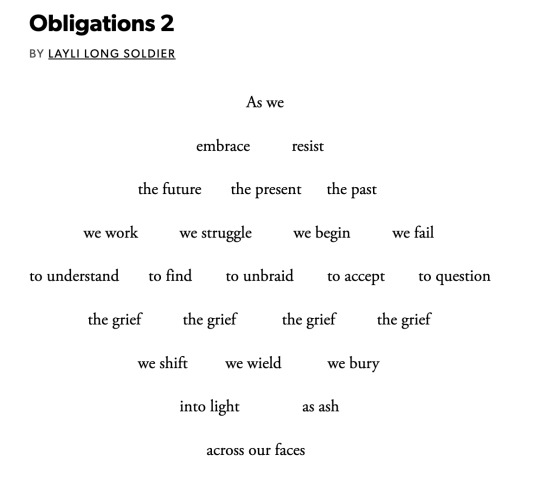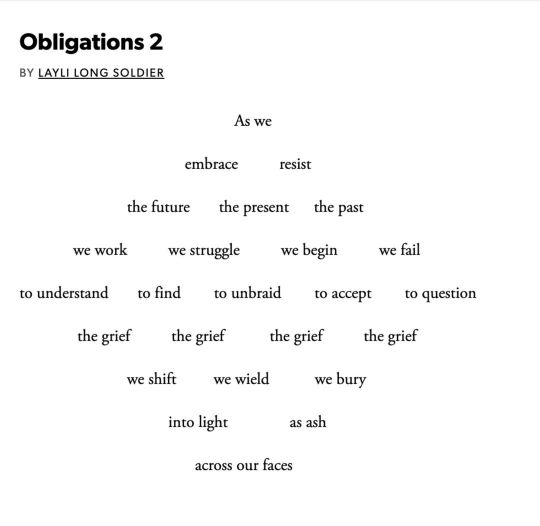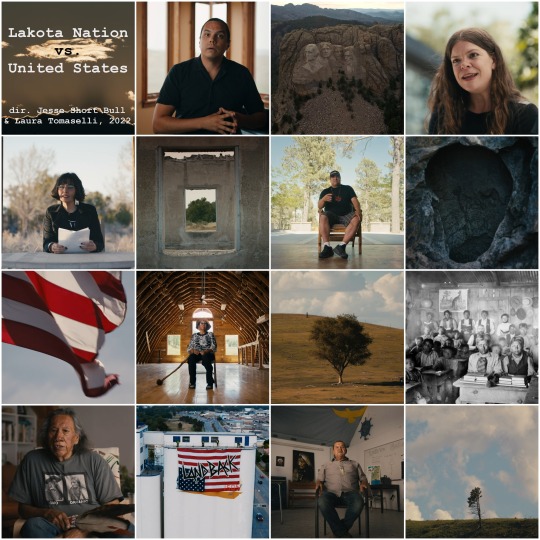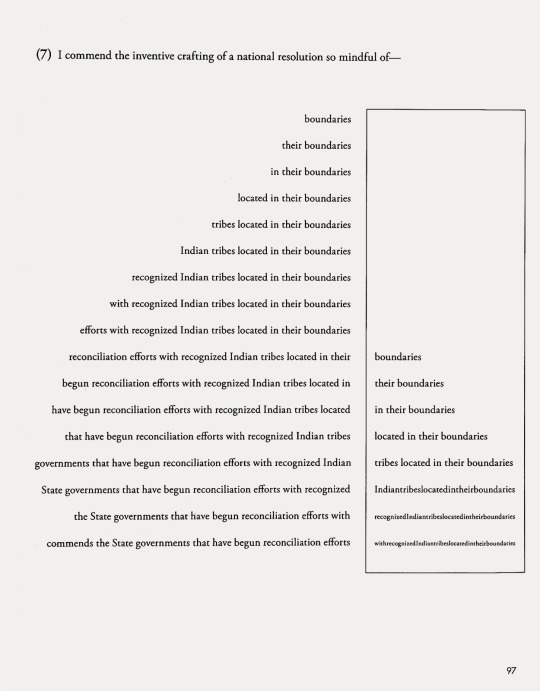#Layli Long Soldier
Text

obligations 2 by Layli Long Soldier
1K notes
·
View notes
Text

Layli Long Soldier, Resolutions (2), in WHEREAS, Graywolf Press, Minneapolis, MN, 2017, p. 90
Plus: Layli Long Soldier reads and discusses Resolution 2 on August 14, 2020, from her home in Sante Fe, NM [Library of Congress, Washington, D.C.]
#graphic design#poetry#reading#book#layli long soldier#graywolf press#library of congress#2010s#2020s
38 notes
·
View notes
Text
"One trader named Andrew Myrick is famous for his refusal to provide credit to Dakota people by saying, 'If they are hungry, let them eat grass.' // There are variations of Myrick’s words, but they are all something to that effect. // When settlers and traders were killed during the Sioux Uprising, one of the first to be executed by the Dakota was Andrew Myrick. // When Myrick’s body was found, / his mouth was stuffed with grass. // I am inclined to call this act by the Dakota warriors a poem."
Read it here | Reblog for a larger sample size!
#closed polls#polls#poetry#poems#poetry polls#poets and writing#tumblr poetry#have you read this#sometimes we get extra options as a treat#38#layli long soldier#38 layli long soldier#the dakota 38#the sioux uprising#admin faves
11 notes
·
View notes
Text

Obligations
16 notes
·
View notes
Text

Layli Long Soldier, Whereas
93 notes
·
View notes
Text
“As we
embrace/resist
the future/the present/the past
we work/we struggle/we begin/we fail
to understand/to find/to unbraid/to accept/to question
the grief/the grief/the grief/the grief
we shift/we wield/we bury
into light/as ash
across our faces.”
Obligations 2 by Layli Long Soldier
6 notes
·
View notes
Text

Lakota Nation vs. United States
directed by Jesse Short Bull and Laura Tomaselli, 2022
#Lakota Nation vs. United States#Jesse Short Bull#Laura Tomaselli#Nick Estes#Mary Katherine Nagle#Layli Long Soldier#Nick Tilsen#Phyllis Young#Milo Yellow Hair#Henry Red Cloud#movie mosaics
7 notes
·
View notes
Quote
Everything is in the language we use.
Layli Long Soldier, “38” from Whereas
45 notes
·
View notes
Text

12 notes
·
View notes
Text
Whereas the word whereas . . . is a qualifying or introductory statement, a conjunction, a connector . . . Whereas, I have learned to exist and exist without your formality, saltshakers, plates, cloth. Without the slightest conjunctions to connect me.
Whereas by Layli Long Soldier
2 notes
·
View notes
Text
38
Here, the sentence will be respected.
I will composed each sentence with care by minding what the rules of writing dictate.
For example, all sentences will begin with capital letters.
Likewise, the history of the sentence will be honored by ending each one with appropriate punctuation such as a period or a question mark, thus bringing the idea to (momentary) completion.
You may like to know, I do not consider this a “creative piece.”
I do not regard this as a poem of great imagination or a work of fiction.
Also, historical events will not be dramatized for an interesting read.
Therefore, I feel most responsible to the orderly sentence; conveyor of thought.
That said, I will begin.
You may or may not have heard about the Dakota 38.
If this is the first time you've heard of it, you might wonder, “What is the Dakota 38?”
“The Dakota 38” refers to the thirty-eight Dakota men who were executed by hanging, under orders from President Abraham Lincoln.
To date, this is the largest “legal” mass execution in U.S. history.
The hanging took place on December 26th, 1862—the day after Christmas.
This was the same week that President Lincoln signed The Emancipation Proclamation.
In the preceding sentence, I italicize “same week” for emphasis.
There was a movie titled Lincoln about the presidency of Abraham Lincoln.
The signing of The Emancipation Proclamation was included in the film Lincoln; the hanging of the Dakota 38 was not.
In any case, you might be asking, “Why were thirty-eight Dakota men hung?”
As a side note, the past tense of hang is hung, but when referring to the capital punishment of hanging, the correct tense is hanged.
So it's possible that you're asking, “Why were thirty-eight Dakota men hanged?”
They were hanged for The Sioux Uprising.
I want to tell you about The Sioux Uprising, but I don't know where to begin.
I may jump around and details will not unfold in chronological order.
Keep in mind, I am not a historian.
So I will recount facts as best I can, given limited resources and understanding.
Before Minnesota was a state, the Minnesota region, generally speaking, was the traditional homeland for Dakota, Anishinaabeg and Ho-Chunk people.
During the 1800s, when the U.S. expanded territory, they “purchased” land from the Dakota people a well as the other tribes.
But another way to understand the sort of “purchase” is: Dakota leaders ceded land to the U.S. Government in exchange for money and goods, but most importantly, the safety of their people.
Some say that Dakota leaders did not understand the terms they were entering, or they never would have agreed.
Even others call the entire negotiation, “trickery.”
But to make whatever-it-was official and binding the U.S. Government drew up an initial treaty.
This treaty was later replaced by another (more convenient) treaty, and then another.
I've had difficulty unraveling the terms of these treaties, given the legal speak and congressional language.
As treaties were abrogated (broken) and new treaties were drafted, one after another, the new treaties often referenced old defunct treaties and it is a muddy, switchback trail to follow.
Although I often feel lost on this trail, I know I am not alone.
However, as best as I can put the facts together, in 1851, Dakota territory was contained to a twelve-mile by one-hundred-fifty-mile-long strip along the Minnesota river.
But just seven years later, in 1858, the northern portion was ceded (taken) and the southern portion was (conveniently) allotted, which reduced Dakota land to a stark ten-mile tract.
These amended and broken treaties are often referred to as The Minnesota Treaties.
The word Minnesota comes from mni which means water; sota which means turbid.
Synonyms for turbid include muddy, unclear, cloudy, confused and smoky.
Everything is in the language we use.
For example, a treaty is, essentially, a contract between two sovereign nations.
The U.S. treaties with the Dakota Nation were legal contracts that promised money.
It could be said, this money was payment for the land the Dakota ceded; for living within assigned boundaries (a reservation); and for relinquishing rights to their vast hunting territory which, in turn, made Dakota people dependent on other means to survive; money.
The previous sentence is circular, which is akin to so many aspects of history.
As you may have guessed by now, the money promised in the turbid treaties did not make it into the hands of the Dakota people.
In addition, local government traders would not offer credit to “Indians” to purchase food or goods.
Without money, store credit or rights to hunt beyond their ten-mile tract of land, Dakota people began to starve.
The Dakota people were starving.
The Dakota people starved.
In the preceding sentence, the word “starved” does not need italics for emphasis.
One should read, “The Dakota people starved,” as a straightforward and plainly stated fact.
As a result—and without other options but to continue to starve—Dakota people retaliated.
Dakota warriors organized, struck out and killed settlers and traders.
This revolt is called The Sioux Uprising.
Eventually, the U.S. Cavalry came to Mnisota to confront the Uprising.
More than one thousand Dakota people were sent to prison.
As already mentioned, thirty-eight Dakota men were subsequently hanged.
After the hanging, those one thousand Dakota prisoners were released.
However, as further consequence, what remained fo Dakota territory in Mnisota was dissolved (stolen).
The Dakota people had no land to return to.
This means they were exiled.
Homeless, the Dakota people of Mnisota were relocated (forced) onto reservations in South Dakota and Nebraska.
Now, every year, a group called The Dakota 38 + 2 Riders conduct a memorial horse rider from Lower Brule, South Dakota to Mankato, Mnisota.
The Memorial Riders travel 325 miles on horseback for eighteen days, sometimes through sub-zero blizzards.
They conclude their journey on December 26, the day of the hanging.
Memorials help focus our memory on particular people or events.
Often, memorials come in the forms of plaques, statues or gravestones.
The memorial for the Dakota 38 is not an object inscribed with words, but an act.
Yet, I started this piece because I was interested in writing about grasses.
So, there is one other event to include, although it's not in chronological order and we must backtrack a little.
When the Dakota people were starving, as you may remember, government traders would not extend store credit to “Indians.”
One trader named Andrew Myrick is famous for his refusal to provide credit to Dakotas by saying, “If they are hungry, let them eat grass.”
There are variations on Myrick's words, but they are all something to that effect.
When settlers and traders were killed during the Sioux Uprising, one of the first to be executed by the Dakota was Andrew Myrick.
When Myrick's body was found, his mouth was stuffed with grass.
I am inclined to call this act by the Dakota warriors a poem.
There's irony in their poem.
There was no text.
“Real” poems do not “really” require words.
I have italicized the previous sentence to indicate inner dialogue, a revealing moment.
But, on second thought, the particular words "Let them eat grass" click the gears of the poem into place.
So, we could also say, language and word choice are crucial to the poem's work.
Things are circling back again.
Sometimes, when in a circle, if I wish to exit, I must leap.
And let the body swing.
From the platform.
Out
to the grasses.
— Layli Long Soldier (1973–)
When the Light of the World Was Subdued, Our Songs Came Through: A Norton Anthology of Native Nations Poetry (2020)
#Layli Long Soldier#38#Dakota 38#Native American#poem#poet#poetry#history#American history#When the Light of the World Was Subdued Our Songs Came Through
19 notes
·
View notes
Text

Layli Long Soldier, Resolutions (7), in WHEREAS, Graywolf Press, Minneapolis, MN, 2017, p. 97
41 notes
·
View notes
Text

2 notes
·
View notes
Text

39 notes
·
View notes
Text
Obligations 2 | Layli Long Soldier
-Oglala Lakota poet
As we
embrace resist
the future the present the past
we work we struggle we begin we fail
to understand to find to unbraid to accept to question
the grief the grief the grief the grief
we shift we wield we bury
into light as ash
across our faces
Her Work
Amazon
POETRY FOUNDATION
View On WordPress
#Layli Long Soldier#native american heritage month#native american heritage month 2023#native poets#Poem#poet#Poetry
4 notes
·
View notes
Text
Lakota Nation vs United States Review- A Masterpiece In Documentary Filmmaking
This documentary starts with a quote from Layli Long Soldier that sums up what this film truly means. “The Oceti Sakowin are Lakota, Nakota, and Dakota People together. These are the names we have called ourselves for thousands of years, which are still used today and often preferred. At times the word Sioux, Indian, American Indian, or Native American are used to identify us, though we never…

View On WordPress
#IFC#Jesse Short Bull#Lakota Nation vs United States#Lauren Tomaselli#Layli Long Soldier#Native Americans#Oglata Lakota
5 notes
·
View notes